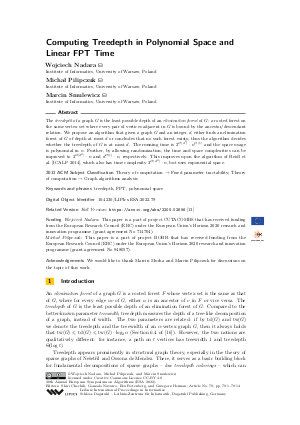@InProceedings{nadara_et_al:LIPIcs.ESA.2022.79,
author = {Nadara, Wojciech and Pilipczuk, Micha{\l} and Smulewicz, Marcin},
title = {{Computing Treedepth in Polynomial Space and Linear FPT Time}},
booktitle = {30th Annual European Symposium on Algorithms (ESA 2022)},
pages = {79:1--79:14},
series = {Leibniz International Proceedings in Informatics (LIPIcs)},
ISBN = {978-3-95977-247-1},
ISSN = {1868-8969},
year = {2022},
volume = {244},
editor = {Chechik, Shiri and Navarro, Gonzalo and Rotenberg, Eva and Herman, Grzegorz},
publisher = {Schloss Dagstuhl -- Leibniz-Zentrum f{\"u}r Informatik},
address = {Dagstuhl, Germany},
URL = {https://drops-dev.dagstuhl.de/entities/document/10.4230/LIPIcs.ESA.2022.79},
URN = {urn:nbn:de:0030-drops-170175},
doi = {10.4230/LIPIcs.ESA.2022.79},
annote = {Keywords: treedepth, FPT, polynomial space}
}

 Creative Commons Attribution 4.0 International license
Creative Commons Attribution 4.0 International license

